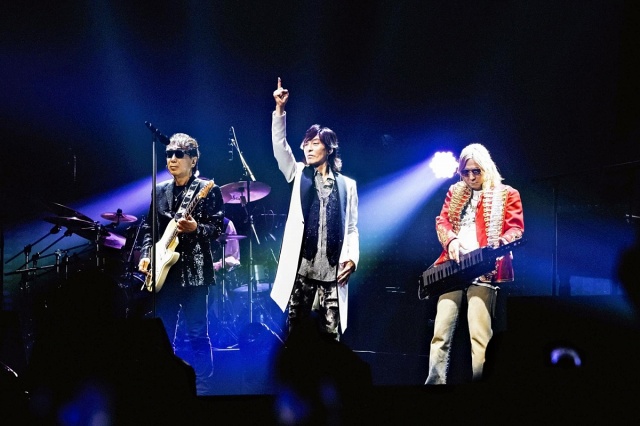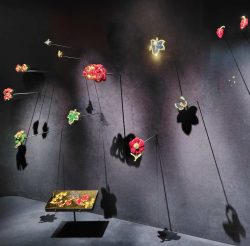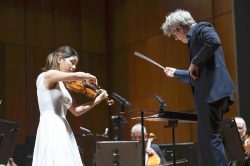Tetsuya Komuro of TM Network Reflects on Band’s Impact on J-Pop 40 Years After Debut; ‘Get Wild’ Gets Revamp to Mark Anniversary

TM Network perform at their 40th anniversary concert on May 18. From left: Naoto Kine, Takashi Utsunomiya and Tetsuya Komuro
12:00 JST, July 5, 2024
The J-pop trio TM Network continues to make music as they celebrate the 40th anniversary of their debut.
Most recently, their song “Get Wild Continual,” released by Sony Music Labels Inc., was used in the Netflix movie “City Hunter,” which has been available on the streaming service since late April.
The group has made a significant impact on the J-pop music scene with their catchy songs and by using such technologies as synthesizers.
“We wanted to get popular, but we didn’t want to conform,” TM Network leader Tetsuya Komuro said.
One of the songs, “Get Wild,” shortened to “Gewai,” is beloved by many, regardless of age. According to Komuro, the director of “City Hunter” requested a version of the song that stays true to the original but also adds something new.
At first, it sounds as if the song has only slightly changed. However, nearly everything was recreated, Komuro said.
“The tempo remains the same as the original, but I think it feels [a bit] faster when you compare them,” Komuro said. “We applied techniques in the bass and rhythm to make it sound as if it was moving forward.”
Komuro, vocalist Takashi Utsunomiya and guitarist Naoto Kine debuted on April 21, 1984. Despite name changes and “ending” their activities, Komuro said the reason for them to remain as a group is that they “show generosity” toward each other. All three members took pride in being creators and were open to each other’s innovative ideas.
They also preferred not to engage in mere pleasantries. There were even times when Komuro was unaware when the other members left after a performance. He described their relationship to one that might be “similar to that of brothers.”

Tetsuya Komuro
From the late 1980s through the 90s, the group had many hit songs, including “Self Control” and “Love Train,” which used cutting-edge synthesizer sounds and melodies that are easy to listen to.
“If it’s just the vocals, people don’t say ‘That’s new,’ and if it’s just the instrumental part, we wouldn’t be in the genre,” he said of the balance between innovativeness and popularity.
Komuro said that finding the perfect balance between the two led to the creation of the J-pop genre.
In 1994, the band suddenly announced an “end” to the group. Around the same time, Komuro began producing for such artists as TRF and Namie Amuro, becoming a leading figure in the 1990s J-pop scene.
Preceding this success, Komuro said being a part of the group provided him with opportunities to just “spontaneously try out his ideas as they popped up and just go for it.”
He expressed his gratitude and said, “I’m thankful to the other two for creating such an environment.”
Komuro, analyzing the group’s impact on music history, said the band is proud of its role in laying the foundation of J-pop.
“We used and were used as a testing ground for the evolution of technology,” he said. “We existed at the turning point of the evolutional change of media and tools.”
On tour
During their performance at K-Arena Yokohama on May 18, as part of their 40th anniversary tour, the trio appeared on stage in front of dazzling lights. As the first notes of “Self Control” started to be played, the venue instantly filled with excitement.
At first, I was concerned about Utsunomiya’s appearance, as he looked noticeably thinner on TV, but after hearing his strong voice, I felt reassured.
They didn’t talk between songs — unchanged from before. Instead, Komuro’s dance music by synthesizer filled in the gap between songs.
Kine and Komuro also performed “Carry on the Memories,” singing lyrics that reflect their tumultuous music careers, and showed a more emotional and vulnerable side, a departure from their usual image.
To everyone’s surprise, there was an encore after the show, and Takahiro Matsumoto from B’z, who had once been a supporting member, stood on stage. He played the guitar and ended the performance on a high with “Be Together,” and the fans exploded with excitement.
The carefully curated set list, featuring contemporary versions of “1974,” “Get Wild,” as well as early classics, showcased Komuro’s pride in being a “testing ground for the evolution of technology,” as he put it.
It made me think, “I want to hear those songs, too,” played by them as they are now.
"Culture" POPULAR ARTICLE
-

Van Cleef & Arpels Dazzles with Art Deco Artisanry at Tokyo Exhibit
-

Disney’s ‘Twisted-Wonderland’ Animated Series Puts Villains in Spotlight: New Show Features School Inspired by Classic Disney Films
-

Ayumi Hamasaki’s Shanghai Concert Canceled Day Before Schedule as Part of Beijing Backlash
-

‘The World Masterpiece Theater Series’ Celebrates 50 Years; Animator Looks Back on Creating Anime Classics
-

Popularity of Piggy Banks Across Time and Place Seen at Bank’s Museum of Money Boxes in Hyogo Pref.
JN ACCESS RANKING
-

Tokyo Economic Security Forum to Hold Inaugural Meeting Amid Tense Global Environment
-

Keidanren Chairman Yoshinobu Tsutsui Visits Kashiwazaki-Kariwa Nuclear Power Plant; Inspects New Emergency Safety System
-

Imports of Rare Earths from China Facing Delays, May Be Caused by Deterioration of Japan-China Relations
-

University of Tokyo Professor Discusses Japanese Economic Security in Interview Ahead of Forum
-

Japan Pulls out of Vietnam Nuclear Project, Complicating Hanoi’s Power Plans























